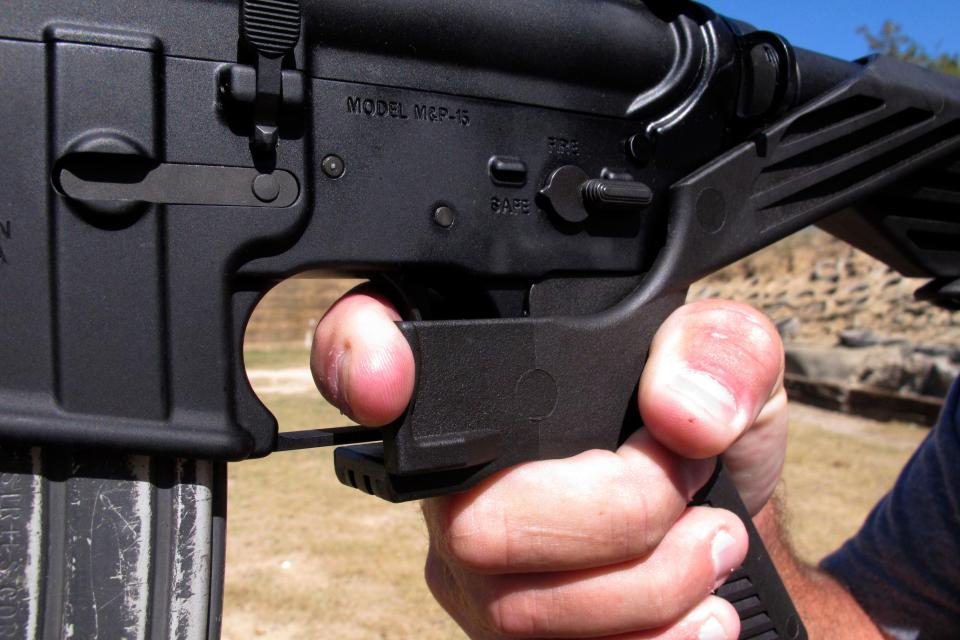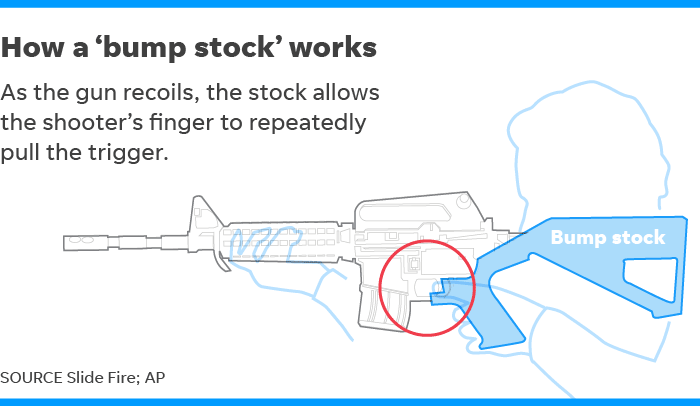'Functioning like a machine gun'? Supreme Court debates whether bump stocks are illegal
WASHINGTON ? The Supreme Court on Wednesday appeared deeply torn about whether the devices that turn a semi-automatic rifle into something closer to a machine gun are legal, with some indicating a wariness over striking down the ban on the controversial devices known as "bump stocks."
Conservatives ?who dominate the court ?expressed concern about the harm caused by the devices, but wondered whether the federal government too broadly interpreted the law when declaring “bump stocks” illegal in 2018.
“I can certainly understand why these items should be made illegal,” Justice Neil Gorsuch told the Justice Department during oral arguments on whether the ban should be upheld. “But we’re dealing with a statute that was enacted in the 1930s, and through many administrations, the government took the position that these bump stocks are not machine guns.”
More: Are bump stocks illegal? Supreme Court will decide fate of Trump ban
Justice Barrett: 'Sympathetic,' but the law seems unclear
The debate is one of several gun-related cases before the Supreme Court this year, and comes against an election-year backdrop of gun violence that continues to plague the country. The Valentine’s Day mass shooting in Kansas City was the 50th reported so far in 2024.
At issue in the bump stocks case was whether to strike down a Trump-era ban on the devices ? a question that many of the justices struggled with.
“Intuitively, I’m entirely sympathetic to your argument. It seems like, yes, that this is functioning like a machine gun would,” Justice Amy Coney Barrett said. “I think the question is, why didn’t Congress pass that legislation to make this cover it more clearly?”
Guns with bump stocks used to mow down people at a Las Vegas concert

After a gunman used bump stocks on some of his 22 semiautomatic rifles to mow down concertgoers in Las Vegas in 2017, then-President Donald Trump directed the Justice Department to regulate the devices.
But the Bureau of Alcohol, Tobacco, Firearms and Explosives’ determination that a bump stock met the definition of a machine gun, which are illegal for private use, was different from what the agency said in the past ? another sticking point for some of the justices.
The court’s three liberal justices, meanwhile, repeatedly tried to bring the focus back to the effect of the bump stocks.
“At some point, you have to apply a little bit of common sense to the way you read a statute,” said Justice Elena Kagan, who used to go hunting with the late Justice Antonin Scalia, “and understand that what this statute comprehends is a weapon that fires a multitude of shots with a single human action.”
What makes a gun 'automatic'?
Bump stocks combine two legal devices, a plastic stock and a firearm, that together function like a machine gun. The bump stock harnesses the recoil of the rifle to accelerate trigger pulls, technically “bumping” the trigger for each shot after it bounces off the shooter’s shoulder. A rifle can then fire between 400 and 800 rounds per minute.
The Las Vegas shooting, in which 58 people were killed immediately and hundreds were injured, was the deadliest mass shooting in the nation’s history. But it wasn’t the last.

Unlike the high court’s pending decision on a law banning domestic abusers from owning guns, this one doesn’t rest on the 2nd Amendment. Instead, it turns on competing explanations of how a bump stock works and whether it meets the legal definition of a machine gun.
Does it allow the weapon to be continually fired once the shooter depresses the trigger? Or must the gun’s trigger be reactivated by the shooter between every shot?
The amended law, originally passed in 1934 after gangsters like John Dillinger used machine guns to rob banks, refers to “any weapon which shoots, is designed to shoot, or can be readily restored to shoot, automatically more than one shot, without manual reloading, by a single function of the trigger.”
Gun shop owner's lawyer: nothing 'automatic' about a bump stock
The lawyer for Michael Cargill, a gun shop owner and gun rights advocate from Austin, Texas who sued the government over the ban, said there’s nothing “automatic” about using a bump stock. The shooter has to press forward on the front grip of the rifle.
“Everything about the firing process is manual,” said attorney Jonathan Mitchell.
Chief Justice John Roberts asked about the government’s contention that the shooter is not actively thrusting part of the gun forward but simply maintaining pressure.
Either way, Mitchell said, it’s still human effort so can’t be called automatic.

The two sides also disputed how to interpret a “single function of the trigger,” which the government says refers to the action the shooter takes to initiate the firing.
But some justices complained the statute doesn’t specifically say that.
“That’s the language we’re stuck with,” Gorsuch said.
Justice Gorsuch worries owners may face prosecution
He was also among the justices who worried about the consequences for the hundreds of thousands of gun owners who had relied on the government’s pre-2018 interpretations that bump stocks were legal. How would they even know that they now possess an illegal device, he wondered.
“Because people will sit down and read the Federal Register?” he asked the Justice Department’s attorney. “That’s what they do in their evening for fun. Gun owners across the country crack it open next to the fire and the dog.”
Brian Fletcher, the Justice Department’s principal deputy solicitor general, said the ATF’s 2018 decision received a lot of attention by gun owners. He added that the government hasn’t prosecuted, and doesn’t plan to go after, gun owners for buying the device when it was legal.
And the fact that government got the interpretation wrong before, he continued, shouldn’t prevent it fixing it now.
“This court often concludes that the government has interpreted a statute the wrong way and doesn’t hesitate to correct the government’s mistakes,” Fletcher said.
Justice Samuel Alito asked the challenger’s attorney if there’s a reason Congress may have wanted to ban machine guns but not bump stocks.
Justice Sotomayor piqued by 'arthritis' defense
Mitchell said bump stocks can help people with disabilities, those who have problems with finger dexterity or with arthritis.
That prompted an incredulous Justice Sonya Sotomayor to asked why Congress would think a person with arthritis would need to shoot 400 to 800 rounds of ammunition under any circumstance.
“If you don’t let a person without arthritis do that,” she asked, “why would you permit a person with arthritis to do it?”
A decision in the case, Garland v. Cargill, is expected by the end of June.
Related Supreme Court poised to support law banning domestic abusers from owning guns
This article originally appeared on USA TODAY: Supreme Court debates whether gun bump stocks are legal
